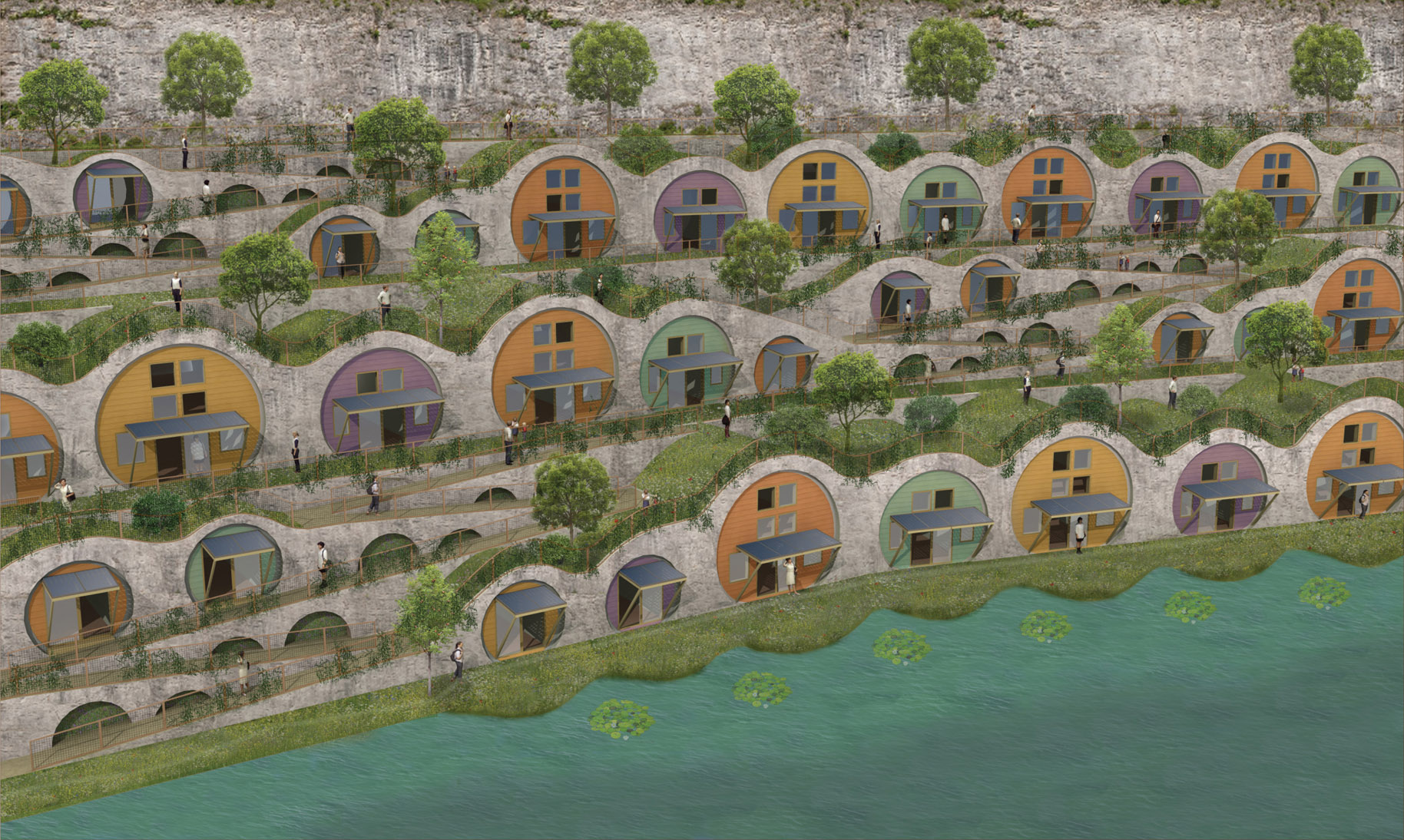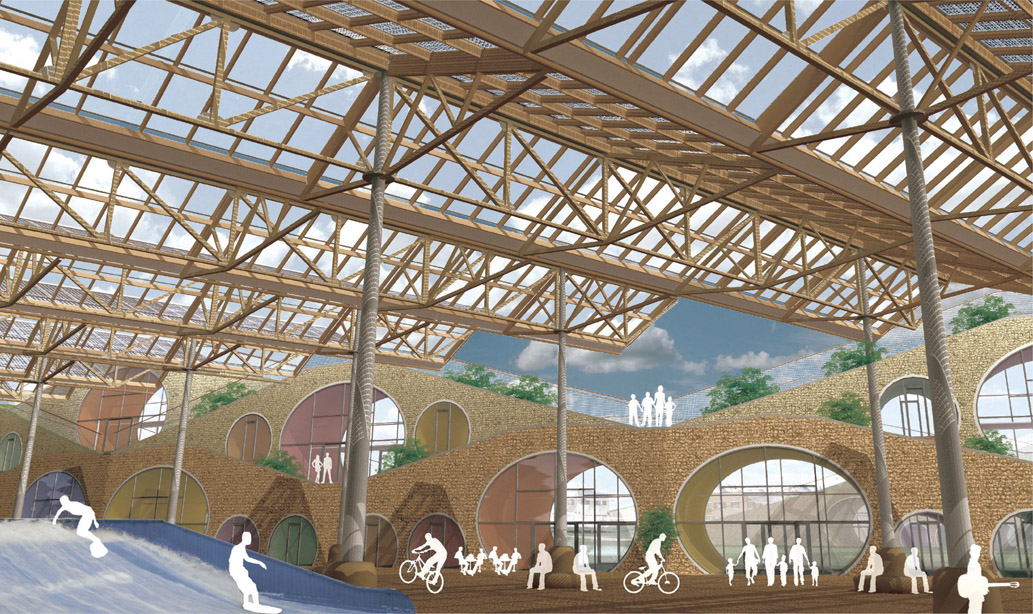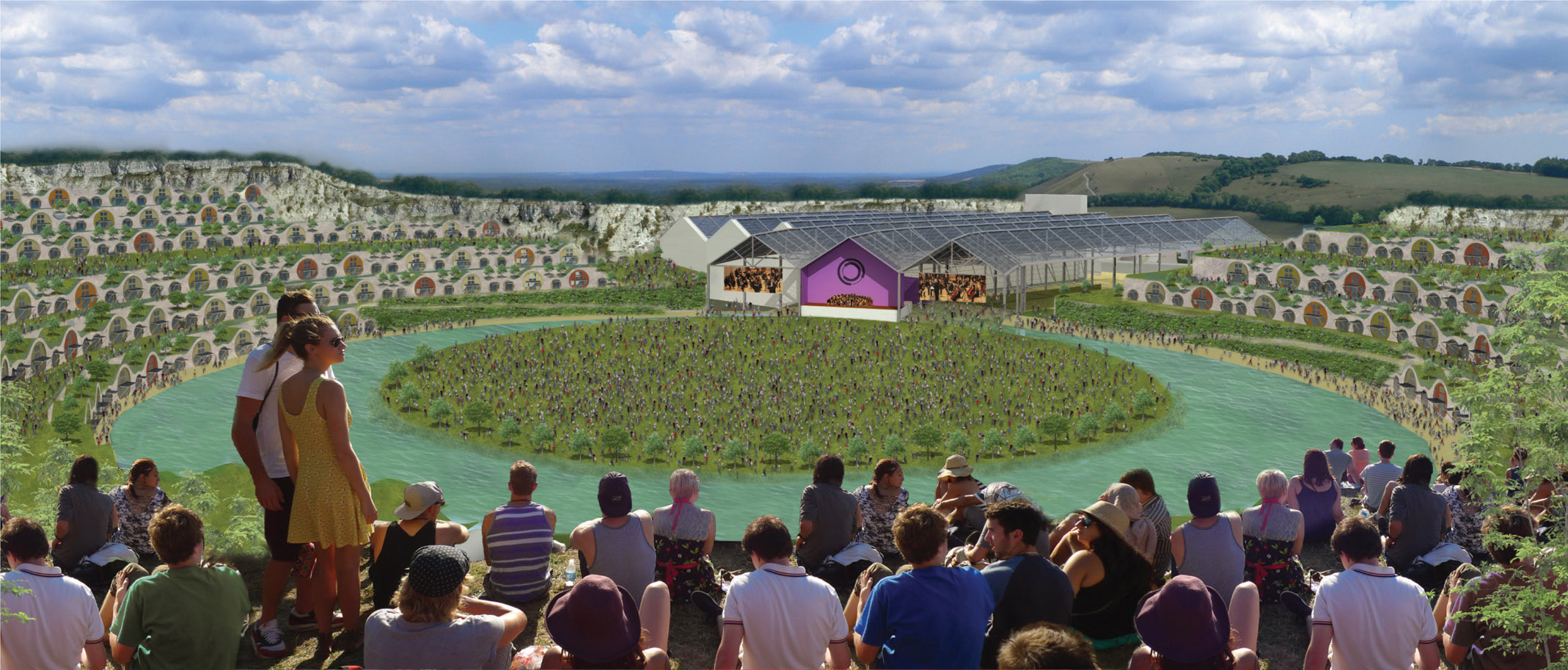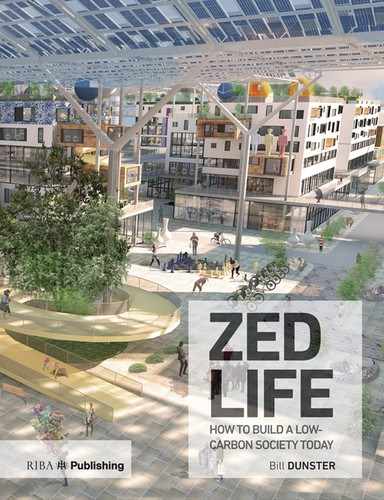Chapter Fourteen
Case Study 4
Shoreham Cement Works: Mixed-Use Regeneration

14.1 Earth-sheltered terrace with communal solar arcade and rooftop allotments.
Overview
With this project, we wanted to offer visitors to the National Park the experience of a zero-carbon/zero-waste future that is fun and has no snags. Our proposal is to make a large holiday park development by transforming a typically ugly redundant quarry into a working and breathing Eden of zero-carbon earth-sheltered holiday houses situated on terraces around the natural amphitheatre of the quarry (fig. 14.1).
Master plan
Our proposal uses landscaped terraces to repair an industrial scar on this cherished part of the countryside. This major leisure complex is imagined on the 48-hectare site of the present Shoreham Cement Works, an inactive chalk quarry with extensive semi-derelict industrial buildings, in the heart of the South Downs National Park. It happens to be the largest brownfield site in the south east of England in a prime position, situated on the river Adur, 5 km north of Shoreham-by-Sea, close to Brighton and within easy reach of London. The proposal would bring new

14.2 Earth-sheltered rural communities for key workers and leisure can blend easily into sublime landscapes particularly in national parks and the green belt.
14.3
New terraces create earth-sheltered ‘hobbit’ holes.
life and employment opportunities into the area in the form of a vibrant zero-energy development. It could include an entertainment venue for open air performances by the world’s leading musicians and performers in a vaulted amphitheatre. Plants and wildlife would return to this degraded environment with the majority, if not all, of the project’s energy demand delivered by renewable energy.
It is the duty of any national park authority to work with other partners to foster the economic and social well-being of the local communities within their national park. A planning inspector recently called the cement works a ‘major visual intrusion at a strategic point within the South Downs’, and called for the restoration of the site, with its unsightly buildings demolished or renovated and the quarry faces suitably treated. The site is considered unsuitable for a major housing development, but its potential for visitor accommodation, employment and leisure uses is recognised, especially if supported by green transport measures. Following lengthy discussions with the local parish council and the South Downs National Park Authority, the proposals have been built into the draft local plan and are currently under public consultation. The proposals are as follows:
Holiday and hotel accommodation
Earth-sheltered holiday accommodation of over 700 units would include:
- 120 accommodation pods located in the main car park on an elevated platform over parking spaces under a solar PV canopy.
- 650 earth-covered vaults, designed to blend in with the surrounding countryside in an ‘inhabited landscape’ (fig. 14.2).
Hotel accommodation of 130 rooms, including:
- 80 hotel rooms in the renovated cement works.
- 50 rooms in a vaulted riverside hotel.
A live/work village
Fifty earth-sheltered homes built into terracing around the existing cement works will provide affordable homes and live/work starter homes (fig. 14.3).
Activities
- Wildlife: Bodies of water are incorporated into the landscape design in two key areas. The consistent water levels in the lakes provide excellent wildlife habitat potential.
- Natural swimming ponds: Two tanked lakes will be created, with perimeter reed water-polishing systems to collect surface water runoff and create wildlife habitat.
- Cable-powered wakeboarding, rock climbing, high-rope centre and mountain biking, plus electric biking sports integrated in quarry landscape with an observation/spectators’ cafe (fig. 14.4, overleaf).

14.4 Terraforming the existing chalk quarry to heal the South Downs.

14.5
Underneath the solar farm with north light.

14.6 Glastonbury meets Glyndebourne.
Covered market
A central area covered by a translucent solar PV canopy, capable of accommodating a farmers’ market for the sale of local produce, along with street food kiosks and other attractions in the style of London’s Borough Market (fig. 14.5).
Covered performance stage
The stage will be located alongside a lake, with a solar PV canopy to protect the performers, while generating electricity. With provision for all-weather performance events, the venue can achieve year-round use (fig. 14.6).
Providing the power
Solar
The site will be entirely powered off-grid by solar PV panels in the form of solar canopies over the main parking, the covered market and the concert stage. Smaller arrays will be interspersed conveniently throughout the site for charging electric vehicles. The electricity generated will give also provide FIT revenues.
Pyrolysis – not incineration
A 1 MW electrical demonstration pyrolysis unit with carbon sequestration facility will be powered by dry agricultural waste from the National Park. The current plans require 1 tonne per hour of local agricultural biomass crop waste which equals one heavy goods vehicle a day. A modest stockpile of this fuel, stored dry under the riverside parking deck, would feed a 1 MW electric output pyrolysis unit, meaning that local agricultural waste, or any other site-generated dry organic waste, can be treated on-site.
Storage
By pumping water from the lower lake to the higher lake while the PV is active, we can effectively create a mini hydroelectric generator when extra power supply is needed. All vehicles and holiday homes will be powered by singles or multiples of the same 500 Wh Fitcraft lithium batteries. Batteries will be charged by the AC microgrid in the renovated cement works building and hired out to users.
Biogas
A medium-scale anaerobic digestion unit, powered by wet organic material, creates biogas that can be compressed on-site and used to fuel converted historic buses and other vehicles.
